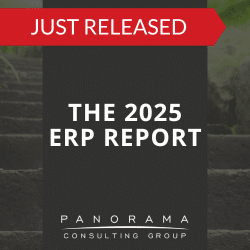Ever feel like everyone around you is speaking “technical-ese”?
Right now, you’re probably recalling a discussion with your IT team or a conference call with a software vendor. Any technology-related conversation can lend itself to an excess of niche terminology, but perhaps none more excessive than cloud ERP discussions.
If your company is currently evaluating the merits of cloud ERP, you know that certain terms have a tendency to muddy communication among project team members.
This is even more true than it was ten years ago. The world of cloud ERP is dynamic, with continuous innovations that promise to further enhance business efficiency.
Understanding these evolving terms and concepts will empower you to lead your organization into the future of digital business, so today, we’re providing a cloud ERP glossary. We’ll demystify cloud terminology and help you get you out of the communication rut that’s stalling your ERP selection.
(If you’re interested in ERP terminology in general, this prior blog post may also be helpful.)
Cloud ERP Conversations We Have Heard
Cloud ERP and Business Intelligence (BI)
Once you start talking about BI, you open a whole can of worms with even more terminology. Conversations like this tend to center around real-time data, dashboards, and advanced analytics.
The most essential term here is “business intelligence,” referring to the process of leveraging data analysis tools to turn raw data into actionable insights. By turning raw data into actionable insights, BI enables leaders to identify trends, optimize processes, and make data-driven decisions.
For example, advanced analytics can help business leaders forecast demand more accurately and reduce inventory costs by identifying and addressing service bottlenecks.
Expert Insight
Before evaluating BI functionality, you must first define the type of key performance indicators (KPIs) you need to track across your business. This will guide you in selecting the right solution.
The User Interface (UI) of Cloud ERP Systems
Cloud ERP vendors often emphasize a user-friendly UI with customizable dashboards, drag-and-drop features, and mobile accessibility.
What does user interface really mean, and what makes a good one? The user interface (UI) is the visual part of the software that shapes how users interact with the system, including how information is presented and how tasks are performed.
A well-designed UI not only enhances usability with intuitive layouts, buttons, and navigation but also plays a crucial role in driving user adoption.
The 2025 Top 10 ERP Systems Report
What vendors are you considering for your ERP implementation? This list is a helpful starting point.
Cloud ERP and Customer Relationship Management (CRM) Integration
Our clients frequently integrate cloud ERP systems with CRM software to streamline customer interactions and data management. Conversations around CRM integration often focus on ensuring that the system can handle the full spectrum of customer interactions.
In the most simple terms, CRM integration means merging customer data from the CRM into the ERP system. However, it can also refer to the fully-integrated CRM functionality found in many ERP systems.
Cloud ERP Terms Used Among the IT Department
To truly enhance your understanding of cloud ERP systems, you must dive into the technical terminology, as well.
Multi-Tenancy
Multi-tenancy is a foundational concept in cloud ERP systems, referring to the architecture where a single instance of software serves multiple customers (tenants). Each tenant’s data is isolated and secure, even though they share the same software infrastructure.
Multi-tenancy allows vendors to maintain a single version of the software for all users, simplifying updates and maintenance. For businesses, this means lower costs, faster updates, and seamless scalability.
However, it also implies less control over the customization of the software, as changes must be compatible with all users on the platform.
Another drawback to multi-tenancy is that sharing infrastructure can raise (sometimes valid) concerns about data breaches.
Single-Tenancy
Single-tenancy involves each customer having their own separate instance of the software and database.
This architecture provides organizations with the flexibility to tailor the ERP system to their specific needs without the constraints of shared architecture. This can be particularly advantageous for highly specialized industries with unique requirements.
The trade-off for customization is increased costs and more complex maintenance, as updates must be managed separately for each instance, potentially leading to version control issues.
SaaS (Software as a Service)
SaaS is a software delivery model where ERP solutions are provided as a subscription service over the internet. This model eliminates the need for in-house hardware and software management.
The SaaS model supports rapid deployment, reduces upfront costs, and shifts the financial burden from capital expenditure to operational expenditure. For a CEO, this means more predictable budgeting and a lower financial barrier to entry.
However, SaaS ERP systems can present concerns around data sovereignty and dependency on the provider’s uptime and service quality.
Vendor lock-in can also be a risk, making it crucial to thoroughly evaluate service level agreements (SLAs).
PaaS (Platform as a Service)
PaaS provides a platform that allows businesses to develop, run, and manage applications without the complexity of building and maintaining the infrastructure. PaaS offers a robust environment for developing customized ERP modules or integrations, enabling greater flexibility and innovation.
While PaaS offers more control than SaaS, it still requires significant IT expertise to manage effectively.
Additionally, dependency on the platform provider can pose risks if the provider’s service quality declines or if the platform undergoes disruptive changes.
IaaS (Infrastructure as a Service)
IaaS delivers cloud computing infrastructure, such as servers, storage, and networking, on a pay-as-you-go basis. In a cloud ERP context, IaaS provides the backbone for hosting the ERP software.
IaaS allows organizations to scale resources dynamically, aligning IT costs closely with demand. This scalability is especially advantageous for businesses experiencing rapid growth or those with fluctuating operational needs.
At the same time, IaaS places more responsibility on internal IT teams to manage the infrastructure, including security, patching, and monitoring.
API (Application Programming Interface)
APIs are a set of protocols that allow different software applications to communicate with each other.
In cloud ERP, APIs enable seamless integration with other business applications, such as CRM, HRMS, or SCM systems. This interconnectedness drives efficiency and ensures data consistency across the enterprise.
While APIs offer extensive flexibility, they can introduce security vulnerabilities if not managed properly.
Additionally, reliance on third-party integrations can create dependencies that complicate upgrades and maintenance.
Software Licensing
In cloud ERP, software licensing typically follows a subscription-based model, where organizations pay for the software as a service rather than owning the software outright. This can include user-based, usage-based, or tiered licensing models.
Understanding the nuances of software licensing is crucial for managing costs and ensuring that the organization is not over- or under-licensed. While most vendors allow for flexibility in scaling the software according to business needs, it’s still important to choose the appropriate licensing model upfront.
EDI (Electronic Data Interchange)
EDI refers to the computer-to-computer exchange of business documents in a standard electronic format between business partners. Within the context of cloud ERP, EDI enables the seamless, automated exchange of data, such as purchase orders, reducing manual entry errors and accelerating transaction processing.
For organizations that rely heavily on trading partners or supply chain integrations, EDI is a critical component that enhances efficiency and accuracy in business operations.
For example, a food and beverage manufacturer might implement a supply chain management system that uses EDI to automatically reorder ingredients when inventory levels drop below a certain threshold. This would minimize stockouts and ensure smooth production without manual intervention.
Terminology for Navigating Cloud ERP Security and Compliance
Security and compliance are paramount in cloud ERP systems, especially as data privacy regulations tighten globally. Here are the terms you need to know.
Data Residency and Data Sovereignty
Data residency refers to the geographical location where data is stored, while data sovereignty relates to the legal and regulatory requirements governing that data based on its location.
Understanding these concepts is critical for compliance with regulations such as GDPR, CCPA, or other regional data protection laws. Choosing a cloud ERP provider with data centers in compliant locations can mitigate risks associated with non-compliance.
Zero Trust Security Model
The Zero Trust model is a security framework that requires all users, whether inside or outside the organization’s network, to be authenticated and continuously validated before gaining access to applications and data.
Implementing a Zero Trust model enhances security in cloud ERP environments by reducing the risk of data breaches. This approach is particularly valuable as it addresses the growing threats posed by remote work and increased third-party integrations.
Identity and Access Management (IAM)
IAM is a framework of policies and technologies that ensure the right individuals access the appropriate resources at the right times for the right reasons. It plays a critical role in securing cloud ERP systems.
Effective IAM strategies protect business software by managing user identities and controlling access to sensitive information. This reduces the risk of unauthorized access.
Disaster Recovery as a Service (DRaaS)
DRaaS is a cloud computing service that enables the replication and hosting of physical or virtual servers by a third party to provide failover in the event of a disaster.
DRaaS offers peace of mind by ensuring business continuity with minimal downtime, protecting cloud ERP investments from data loss or operational disruption.
Data Encryption
Data encryption involves converting information into a code to prevent unauthorized access. In cloud ERP systems, encryption is used both in transit (data moving between your ERP and other systems) and at rest (data stored within the ERP).
Encryption is essential for safeguarding sensitive data against cyber threats and is often a compliance requirement. Cloud ERP providers typically offer strong encryption protocols, which enhance data security without compromising system performance.
Leveraging Cloud ERP Terminology for Strategic Advantage
Understanding the terminology associated with cloud ERP is more than just a technical exercise; it’s a strategic imperative for leaders looking to maximize the value of their digital transformation initiatives.
By familiarizing yourself with these terms, you can engage more effectively with your IT teams, vendors, and other stakeholders, ensuring your cloud ERP investments align with your business objectives.
Contact our ERP selection consultants below to learn how you can make the right technology purchases and ensure a high return on investment.













